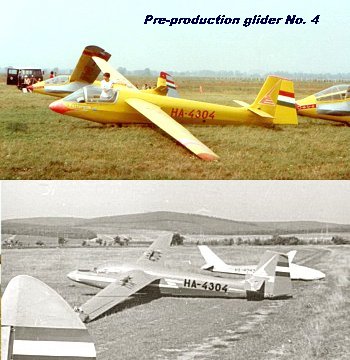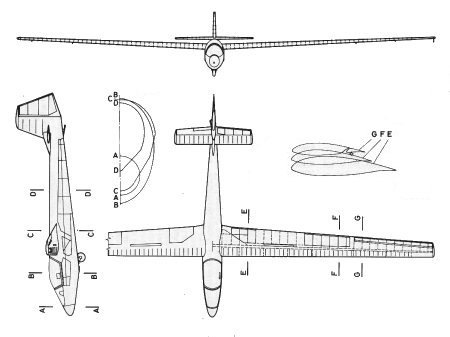HUNGARIAN
GLIDERS
1933-2000
.jpg)
Short history:
After the plan to build the R-25 Mokány had been dropped the demand for a standard class performance glider popped up again in 1964. A committee was formed to decide upon development issues. The development was based on the R-25 Mokány. The following requirements were formulated: the empty mass must be under 200 kg; the best gliding ratio must be in the range of 32-34 at 80 km/h gliding speed; the sinking speed must be under 1,25 m/s at 110 km/h gliding speed. A fuselage similar to that of the R-27 Kópé was chosen and it was decided to test this fuselage with three different wing configurations. The first was an all-metal wing with a combined glued-riveted smooth skin fitted with DFS type airbrakes (this version got the designation of R-252). The second was a wing with Rubik-type corrugated sheet skin, with rectangular midsection and tapered outer panels, and with a trailing edge airbrake (this version got the designation of R-253 and had been proposed by Rubik). The third was the original Mokány wing however with DFS type airbrakes (this version got the designation of R-254).
Comparison test flights were conducted during the first half of 1965 involving the versions R-252 and R-254. The result was, that the R-254 version's performances were equal to those of the Super-Futár and SZD-22 Mucha and slightly better then those of the original Mokány. The performances of the R-252 version were equal to that of the Mucha, however in tight thermals the Mucha climbed better. Since the MHS had been pressing the factory to start the production, the R-254 version was selected for production, and it was decided to build 5 pre-production gliders. The construction of the third wing configuration, the R-253 version, had been postponed a couple of times due to modifications, and finally it was tested only in October, after the decision to build the version of R-254 had been reached. The performance of this version was better then those of the other versions, however unpleasant variable pitching moment had been encountered during airbrake deployment.
 R-254 glider first flew at March 21, 1966. The glider got a new designation and name: E-31 and Esztergom respectively. 50 production gliders had been built, however the target performance requirements were not met. They served as standard class training gliders for pilots who had completed the instruction on the R-26S Góbé. They were in operational use for more then a decade. One example is even flying today in Hungary (2004). One of the pre-production gliders (HA-4304) is under restoration at North Adams Airport in Massachusetts, USA (2004).
R-254 glider first flew at March 21, 1966. The glider got a new designation and name: E-31 and Esztergom respectively. 50 production gliders had been built, however the target performance requirements were not met. They served as standard class training gliders for pilots who had completed the instruction on the R-26S Góbé. They were in operational use for more then a decade. One example is even flying today in Hungary (2004). One of the pre-production gliders (HA-4304) is under restoration at North Adams Airport in Massachusetts, USA (2004).
The glider was certified for winch and aerotow launchings as well as simple aerobatics (spins, chandelles, loops), however in the beginning of the 80s certification for aerobatics was withdrawn.
Structure: All-metal
Wing:
The shoulder wing glider has a cantilever, tapered planform, one-spar wing. The wing in front of the main spar has a box structure covered by specially formed corrugated sheets of duraluminium. These are riveted to the ribs spaced at 825 mm. The booms of the main spar are extruded duraluminium shapes machined to uniform strength. The web is lightened by flanged openings and its thickness is equal that of the skin. Behind the main spar secondary ribs are placed between the main ribs. Split, Frise-type, slotted ailerons and, behind the main spar, DFS airbrakes are fitted. The ailerons have torsion-box leading edges. Their rear part is covered by sheets and is stiffened by polystyrene foam ribs.
The wings are attached to the fuselage at two points. The front transversal and the rear longitudinal steel bolts are connected to spherical bearings in the fuselage. The rear attachment is supported by a diagonal rib, which is connected to the main spar. The main spars of the half wings are connected to each other via a cylindrical double bolt at the centerline of the fuselage.
There are wingtip covers, which are removable. Glued and stitched seams are used on the fabric covering behind the main spar.
Fuselage:
The structure of the fuselage is a combination of sheets, a sheet-girder structure and fabric. Accordingly its skin is a combination of sheets and fabric. The front part of the fuselage, which structure consists of longerons and frames, includes the seat, the controls, the tow hooks and the landing gear. The nose is sheet covered. At the back of the seat the main frame is located, which the front attachment fitting of the wings are connected to.
The canopy's rear part is a blown-up plexiglass fitted into a light-metal frame and opens sideways. The fixed front part is a bent plexiglass. The canopy can be jettisoned in emergency. The seat is adjustable on the ground, however the backrest is adjustable in flight as well.
.jpg)
The upper half of the fuselage's rear part, which supports the tail unit, is a sheet-structure and is connected to the next frame behind the main frame. This is the connection point for the wings' rear attachment fittings as well. The vertical stabilizer connects to an end-frame. The tail unit support and the vertical stabilizer form a homogeneous structure. A duraluminium stay-tube runs between the front part of the fuselage and the tail unit. The required form of the fuselage under the upper half is secured by adequately formed longitudinal sheet-sections covered by fabric. The fabric cover is glued to the frames and longerons and fastened by stitches.
The landing gear consists of a fixed wheel, which is located in front of the c.g., and a steel-band tail skid fitted with a replaceable wearing-plate. The wheel has a torsion rubber disk as spring.
The glider is fitted with one towing hook in the nose and one belly hook for high-winch launching with a common release.
Tail unit:
The horizontal stabilizer is located in front of the vertical stabilizer. Both stabilizers are monocoque structures. The horizontal stabilizer has no ribs. The rudder and the elevator have similar structures - main spar and half-circle cross section leading edge formed as a torsion-box. The ribs' ends are fastened to a trailing edge. Both control surfaces are fabric covered.
.jpg)

| Dimensions: |
| Wing: |
| Span, m: |
14,98 |
| Area, m2: |
11,25 |
| Aspect ratio: |
20,0 |
| Chord (root), m: |
1,02 |
| Chord (tip), m: |
0,48 |
| Airfoil (root), m: |
NACA 643-618 mod. |
| Airfoil (mid-span), m: |
NACA 643-618 mod. |
| Airfoil (tip), m: |
NACA 643-618 mod. |
| Dihedral, degree: |
3 |
| Sweep, degree: |
-1,03 |
| Washout: |
None |
| Aileron: |
| Span, m: |
2,68 |
| Mean chord, m: |
0,25 |
| Total area, m2: |
1,64 |
| Balancing: |
Aerodynamic and 75% mass |
| Flap: |
| Type: |
None |
| Airbrakes: |
| Type: |
DFS |
| Position (upside/downside): |
u/d |
| Total area, m2: |
0,46 |
| Position, % of chord: |
0,362 |
| Horizontal stabilizer: |
| Span, m: |
2,6 |
| Area, m2: |
1,51 |
| Elevator: |
| Span, m: |
2,6 |
| Area, m2: |
0,61 |
| Airfoil: |
NACA 0012-63 mod. |
| Balancing: |
75% aerodynamic |
| Trim: |
Yes |
| Vertical stabilizer and rudder: |
| Total area, m2: |
1,87 |
| Rudder area, m2: |
0,8 |
| Balancing: |
None |
| Fuselage: |
| Length, m: |
7,41 |
| Width, m: |
0,64 |
| Height: |
0,96 |
| Cross section, m2: |
0,55 |
| Landing gear: |
| Type: |
Fixed with rubber disc spring |
| Wheel diameter, m: |
0,3 |
| Masses: |
| Wing, kg: |
? |
| Fuselage, kg: |
? |
| Tail unit, kg: |
? |
| Empty glider, kg: |
230 |
| Gross, kg: |
330 |
| Ballast, kg: |
None |
| Wing loading, kg/m2: |
29,3 |
| Speeds: |
| VNE, km/h: |
250; 1992: 180 |
| Max. speed with open airbrakes, km/h: |
250; 1992: 180 |
| Max. aerotow speed, km/h: |
120 |
| Max. winch speed, km/h: |
110 |
| Max. speed in rough air, km/h: |
165; 1992: 140 |
| Stall speed, km/h: |
65 |
| Performance: |
| Min. sink, m/s (at gliding speed, km/h): |
-0,8/69 |
| Best L/D (at gliding speed, km/h): |
27,2/81 |
| Start methods: |
Winch, Aerotow |

Origin of data and 3-view drawing:
Jereb Gábor: Magyar vitorlázó repülőgépek, Műszaki Könyvkiadó, 1988, Budapest
(Gábor JEREB: Hungarian Gliders, Technical Publishing House, 1988, Budapest)
Gábor FEKECS E-mail: fekecs.gabor@t-online.hu

.jpg)
.jpg)
.jpg)
